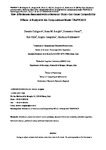How affordances associated with a distractor object affect compatibility effects: A study with the computational model TRoPICALS
| dc.contributor.author | Caligiore, D | |
| dc.contributor.author | Borghi, AM | |
| dc.contributor.author | Parisi, D | |
| dc.contributor.author | Ellis, R | |
| dc.contributor.author | Cangelosi, Angelo | |
| dc.contributor.author | Baldassarre, G | |
| dc.date.accessioned | 2015-10-13T18:55:31Z | |
| dc.date.available | 2015-10-13T18:55:31Z | |
| dc.date.issued | 2013-01 | |
| dc.identifier.issn | 0340-0727 | |
| dc.identifier.issn | 1430-2772 | |
| dc.identifier.uri | http://hdl.handle.net/10026.1/3609 | |
| dc.description.abstract |
Seeing an object activates both visual and action codes in the brain. Crucial evidence supporting this view is the observation of object to response compatibility effects: perception of an object can facilitate or interfere with the execution of an action (e.g., grasping) even when the viewer has no intention of interacting with the object. TRoPICALS is a computational model that proposes some general principles about the brain mechanisms underlying compatibility effects, in particular the idea that top-down bias from prefrontal cortex, and whether it conflicts or not with the actions afforded by an object, plays a key role in such phenomena. Experiments on compatibility effects using a target and a distractor object show the usual positive compatibility effect of the target, but also an interesting negative compatibility effect of the distractor: responding with a grip compatible with the distractor size produces slower reaction times than the incompatible case. Here, we present an enhanced version of TRoPICALS that reproduces and explains these new results. This explanation is based on the idea that the prefrontal cortex plays a double role in its top-down guidance of action selection producing: (a) a positive bias in favour of the action requested by the experimental task; (b) a negative bias directed to inhibiting the action evoked by the distractor. The model also provides testable predictions on the possible consequences of damage to volitional circuits such as in Parkinsonian patients. | |
| dc.format.extent | 7-19 | |
| dc.format.medium | Print-Electronic | |
| dc.language | en | |
| dc.language.iso | eng | |
| dc.publisher | Springer Science and Business Media LLC | |
| dc.subject | Computer Simulation | |
| dc.subject | Hand Strength | |
| dc.subject | Humans | |
| dc.subject | Intention | |
| dc.subject | Learning | |
| dc.subject | Models, Theoretical | |
| dc.subject | Movement | |
| dc.subject | Psychomotor Performance | |
| dc.subject | Reaction Time | |
| dc.subject | Visual Cortex | |
| dc.subject | Visual Perception | |
| dc.title | How affordances associated with a distractor object affect compatibility effects: A study with the computational model TRoPICALS | |
| dc.type | journal-article | |
| dc.type | Journal Article | |
| dc.type | Research Support, Non-U.S. Gov't | |
| plymouth.author-url | https://www.webofscience.com/api/gateway?GWVersion=2&SrcApp=PARTNER_APP&SrcAuth=LinksAMR&KeyUT=WOS:000313053700002&DestLinkType=FullRecord&DestApp=ALL_WOS&UsrCustomerID=11bb513d99f797142bcfeffcc58ea008 | |
| plymouth.issue | 1 | |
| plymouth.volume | 77 | |
| plymouth.publication-status | Published | |
| plymouth.journal | Psychological Research | |
| dc.identifier.doi | 10.1007/s00426-012-0424-1 | |
| plymouth.organisational-group | /Plymouth | |
| plymouth.organisational-group | /Plymouth/Faculty of Health | |
| plymouth.organisational-group | /Plymouth/Faculty of Science and Engineering | |
| plymouth.organisational-group | /Plymouth/Research Groups | |
| plymouth.organisational-group | /Plymouth/Research Groups/Centre for Brain, Cognition and Behaviour (CBCB) | |
| plymouth.organisational-group | /Plymouth/Research Groups/Centre for Brain, Cognition and Behaviour (CBCB)/Brain | |
| plymouth.organisational-group | /Plymouth/Research Groups/Institute of Health and Community | |
| plymouth.organisational-group | /Plymouth/Research Groups/Marine Institute | |
| dc.publisher.place | Germany | |
| dcterms.dateAccepted | 2012-01-30 | |
| dc.identifier.eissn | 1430-2772 | |
| dc.rights.embargoperiod | Not known | |
| rioxxterms.versionofrecord | 10.1007/s00426-012-0424-1 | |
| rioxxterms.licenseref.uri | http://www.rioxx.net/licenses/all-rights-reserved | |
| rioxxterms.licenseref.startdate | 2013-01 | |
| rioxxterms.type | Journal Article/Review |


